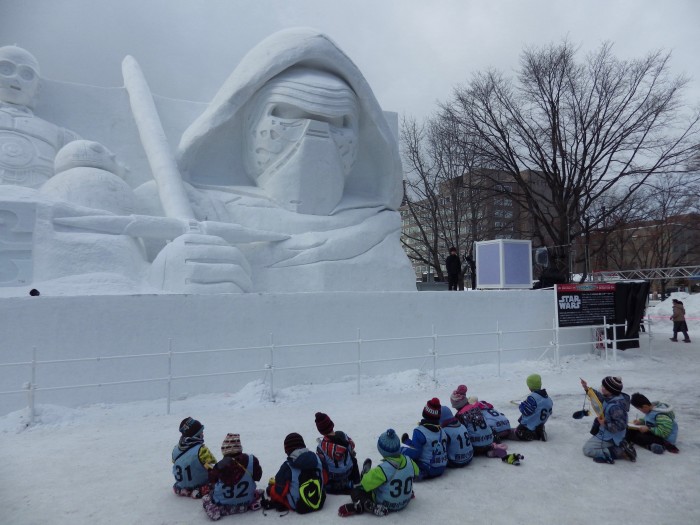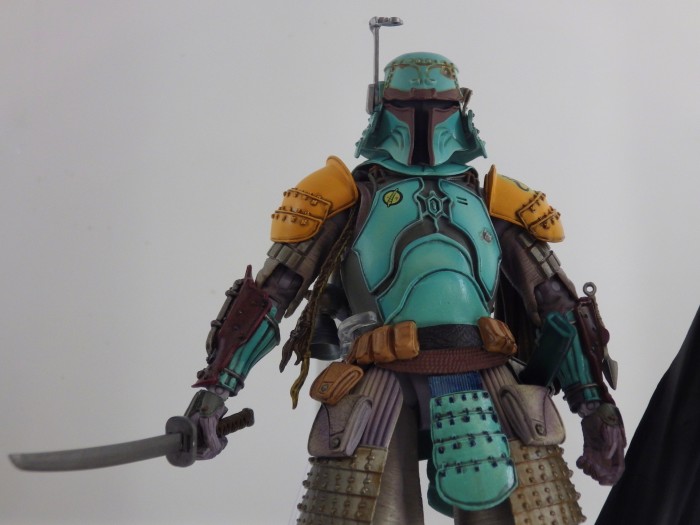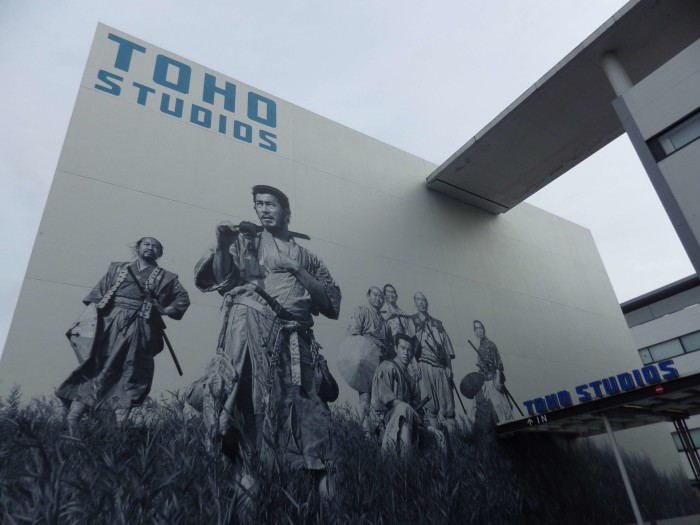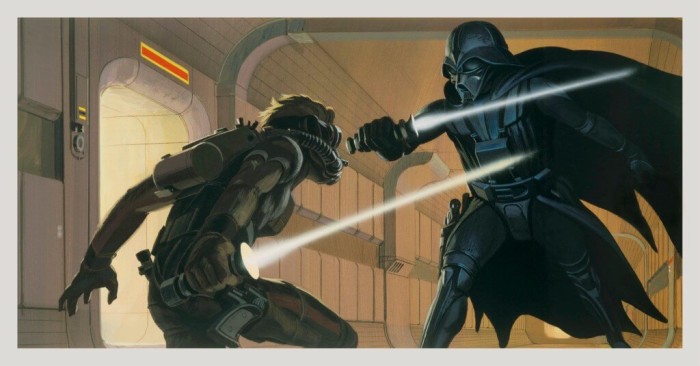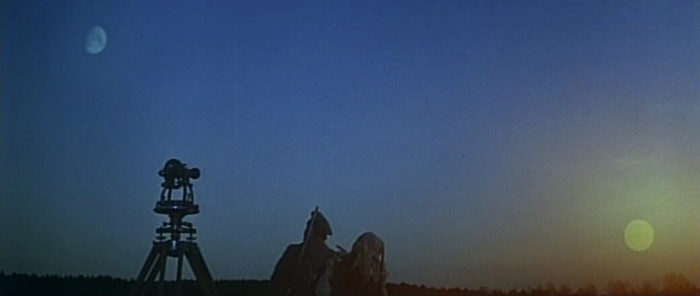Exploring The Japanese Roots Of 'Star Wars'
With Star Wars: A New Hope celebrating the 40th anniversary of its theatrical release this year, this is as good a time as any to dig into the film's history.
Knowledgable film lovers often cite Akira Kurosawa's 1958 film The Hidden Fortress as a key influence on the young George Lucas, as the plot of that film heavily informs the original Star Wars. In it, two squabbling peasants become involved in the rescue of a princess, similar to how C-3PO and R2-D2 would get caught up in the mission to free Leia and deliver the Death Star plans.
As Wookiepedia shows, the first script treatment for Star Wars — a 1973 story synopsis that Lucas shopped around Hollywood — hews even closer in plot to The Hidden Fortress, with Lucas having straight-up plagiarized a description of that movie from a book called The Films of Akira Kurosawa by the late film historian and Japanophile Donald Richie.
But the Japanese roots of Star Wars run deeper than one artist stealing/borrowing from another (as all artists do, to the degree that they are influenced by one another). Let's explore some of those influences: some well-known, others less perhaps so.
The Influence of Phonetics
Phonetics are fair game to talk about, since the language of Star Wars geeks — all those obscure character names we know — often derives from pure aesthetic sound.
Indeed, as he started populating his fictional universe, George Lucas frequently used sounds as the genesis for names. "R2-D2," for example, came about when he was in post-production on American Graffiti with editor and sound designer Walter Murch, and Murch asked Lucas to hand him a film reel and dialogue track: Reel 2, Dialogue 2, or "R2 D2."
Likewise, it is commonly assumed that the word Jedi came from jidaigeki, the Japanese word for "period dramas," like the kind Kurosawa is known for.
Jidaigeki is an academic word. Lucas obviously had a lot of scholarly knowledge about film. But as a student of Japanese cinema, someone who professed to having been "hooked" on the "genius" of Kurosawa, he would have also absorbed the sound of spoken Japanese through film dialogue (even if he could not understand what the words meant and was just relying on subtitles).
However unconsciously, absorbing these phonetics, not only from Japanese films, but also from other foreign films, may have helped Lucas form the sound of all those cool alien and planet names in Star Wars.
We've all heard the names of aliens or fantasy characters that sound fake, like weak attempts at world-building. By contrast, a name like "Chewbacca," for instance, sounds real, maybe because the name is made up of sounds that already form real words in human language. Some have theorized that the name comes from sobaka, the Russian word for "dog." But in Japanese, chuu means "middle," and baka is a common swear word meaning, "fool" or "idiot."
Next time you want to curse at someone, simply spit out the word baka in an angry tone. And there you go – you'll be cursing in Japanese!
Suffice it to say, Chewbacca's name almost sounds like something that would translate out as "mid-level fool" in Japanese. So if you're only a little angry at the person you want to curse at, you can maybe call them a "chuu baka" instead. Or you could throw in a little Gungan, and call them a "bombad" baka. Whatever floats your tribubble bongo.
Casting and Characterization
Though it is hard to imagine anyone other than Sir Alec Guinness playing the part of Obi-Wan Kenobi, Lucas originally sought actor Toshiro Mifune, who carved out a large body of work as a Kurosawa collaborator, starring in many of the director's most well-known jidaigeki classics.
The best way to get a feel for the full importance of Kurosawa and Mifune would be to say they were essentially the Japanese equivalent of Martin Scorsese and Robert De Niro, insofar as some of their collaborations are routinely ranked among the greatest films of all time. Start drawing up a Kurosawa "to-view" list and you'll find yourself drawing up a list of truly incredible movies.
It was Mifune who played Yojimbo, and thereby gave us the prototype for Clint Eastwood's iconic, cigarillo-chewing, poncho-wearing Man with No Name. In cribbing from Kurosawa, you see, Lucas was not so different from Italian director Sergio Leone, whose spaghetti western A Fistful of Dollars was an unauthorized remake of Kurosawa's iconic samurai film.
Both Lucas and Leone lifted wholesale from Kurosawa. In Leone's case, he just happened to be less subtle about it, and it happened to get him sued.
Speaking of westerns, there are certainly elements of the western in Star Wars, most notably, perhaps, in the cowboy-esque cantina showdown between Han Solo and the bug-eyed alien Greedo. But on the whole, Lucas chose to go down a different path with his Kurosawa remake, shooting it in the mode of a swashbuckling space adventure like Buck Rogers.
The parallels between samurai and Jedi (flowing robes, sword-like weapons, Buddhist code of conduct) are fairly obvious, and do not need to be rehashed at length here. Suffice it to say, the Jedi are basically space samurai, with bounty hunters like Boba Fett functioning as space ronin, masterless samurai who sometimes hired themselves out as gang enforcers.
In The Empire Strikes Back documentary A Conversation with the Masters, Lawrence Kasdan, who co-wrote the film's screenplay, said as much when he called Boba Fett "the bad samurai." And yet, as fascinating as it is to see characters in a space fantasy acting out samurai and ronin roles, there is also another kind of interplay going on in these movies: namely, that of the senpai and kohai, or mentor and protege.
The Senpai/Kohai Dynamic
Anyone who ever read the Michael Crichton novel Rising Sun, or watched the film adaptation starring Sean Connery and Wesley Snipes, may recall hearing something about the senpai/kohai dynamic. Connery's white-bearded character explained it in the film's first reel, saying "the senpai is the senior man who guides the junior man." Though in Japanese society, the roles are not limited to men, but extend to include people across all different social strata. Hierarchies are formed in schools, clubs, businesses, everywhere.
In Star Wars, of course, Sir Alec Guinness would portray a different white-bearded mentor, named Obi-Wan Kenobi. In Obi-Wan, we see a figure who embodies not only the Wise Old Man archetype of Joseph Campbell, but also the concept of a senpai, or mentor — with Luke being his kohai, or protege.
Originally, the character who would become Obi-Wan went by the name Luke, however. And there was no Luke, at least not the farmboy we know.
Again, looking back on the 1973 story synopsis, you can see that Lucas first envisioned Luke as an older general, similar to Toshiro Mifune's character in The Hidden Fortress. This is probably why Lucas initially wanted Mifune to play Obi-Wan, because Mifune was the very inspiration for General Luke Skywalker, the proto-Obi-Wan.
Incidentally, Kurosawa himself was not above stealing from the greats. Two of his films, Throne of Blood and Ran, were sourced directly from Shakespeare. Kurosawa simply changed the setting, transposing the tragedies of Macbeth and King Lear to feudal Japan.
As Lucas further developed his ideas, and merged them with other people's ideas, Star Wars eventually became much more than a Kurosawa rip-off, of course. Nevertheless, it is funny to imagine A New Hope without the Luke/Obi-Wan relationship.
After all, Lucas would build up the whole master/apprentice tutelage into an integral part of the Star Wars mythos, even devising a so-called "Rule of Two" that he later worked into The Phantom Menace (a film that imported discarded Hidden Fortress concepts back into Star Wars, with its princess disguised as a pauper, among other things).
In the words of Yoda, "Always two there are, no more, no less. A master and an apprentice." This Sith rule, and the master/apprentice tradition in Jedi culture, owe a great deal, perhaps, to the senpai-kohai tradition in Japanese culture.
Bizarro Darth (Mifune as Vader)
Though Toshiro Mifune balked at the chance to play Obi-Wan, somewhere out there, there is an alternate reality where he might have played Darth Vader, with his face showing, under a black space-samurai helmet. According to Mifune's daughter, Lucas also courted the actor for the Vader role. This was before concept artist Ralph McQuarrie came up with the design for the character's skull-like mask.
In one of five original McQuarrie paintings commissioned by George Lucas for his 1975 pitch meeting at Fox (before Star Wars was ever green-lit), you can see Deak Starkiller, another early iteration of Luke Skywalker, with a weird contraption affixed to his face. He is fighting Darth Vader. Vader has his mask on, too. From Deak's mask, there is a tube snaking up over his shoulder, into a tank on his back. It almost looks like scuba gear.
This is because they were supposed to be squaring off in a passage between ships, where there was no air, only the vacuum of space. As McQuarrie initially intended it, the mask was just an apparatus for breathing in space. And so what we have here looks, definitively, to be one of those "happy accidents" that people who work in collaborative creative mediums are always gushing about. The Vader mask was never meant to stick!
Ironically, not only did the mask graft itself to the character as a permanent symbol of the Dark Side; it also lodged itself in the public's imagination, as an emblem of modern myth.
Imagine what it would have been like if a maskless Vader had made it into A New Hope. The sight of the Sith Lord, whose grim visage was meant to inspire fear in denizens of the Galactic Empire, might, instead, have inspired chuckles — with the noble Toshiro Mifune trotting about in a kabuto helmet and bad 1970s costume, as some sort of Bizarro Darth (without the benefit of James Earl Jones to voice him, either.)
Were it not for Ralph McQuarrie, Vader could have easily turned out like Dark Helmet, the character played by Rick Moranis in the Mel Brooks spoof Spaceballs.
Kurosawa Deep Cut: Dersu Uzala
In wrapping up, it might be nice to leave fans with something for their Kurosawa to-view list. You can also trace Kurosawa's influence through the Star Wars sequels and prequels, with the best of them, The Empire Strikes Back, pulling from a lesser-known Kurosawa film called Dersu Uzala.
Despite the fact that it won the 1975 Oscar for Best Foreign Language Film, this one surely qualifies as a Kurosawa "deep cut," especially since it can be tough to track down a good quality version. The title Dersu Uzala is not available on the U.S. iTunes Store, and Amazon only has a low-quality SD dubbed version available to stream.
Even so, a few choice plot elements from the film do merit mention. Set in Siberia, Dersu Uzala also features a snowbound setting in which two men survive a blizzard together. Shades of Han and Luke on the ice planet Hoth.
The cover of the Japanese DVD even looks like it could be an image straight out of The Empire Strikes Back: that moment when Han waved in the snowspeeder, with the frozen tundra stretching out ahead of him, and the morning sun gleaming off its surface.
There are other images, too, like when a character looks out over a flat horizon, and sees the moon and sun in the sky simultaneously. Shades of Tatooine's "binary sunset."
That brings us back to where it all began, 40 years ago now. As the Star Wars saga goes rolling ever forward, rather like BB-8, who knows what other ripples from Japanese cinema might spread across the pond.
May the Force be with you from Tokyo, Japan!

